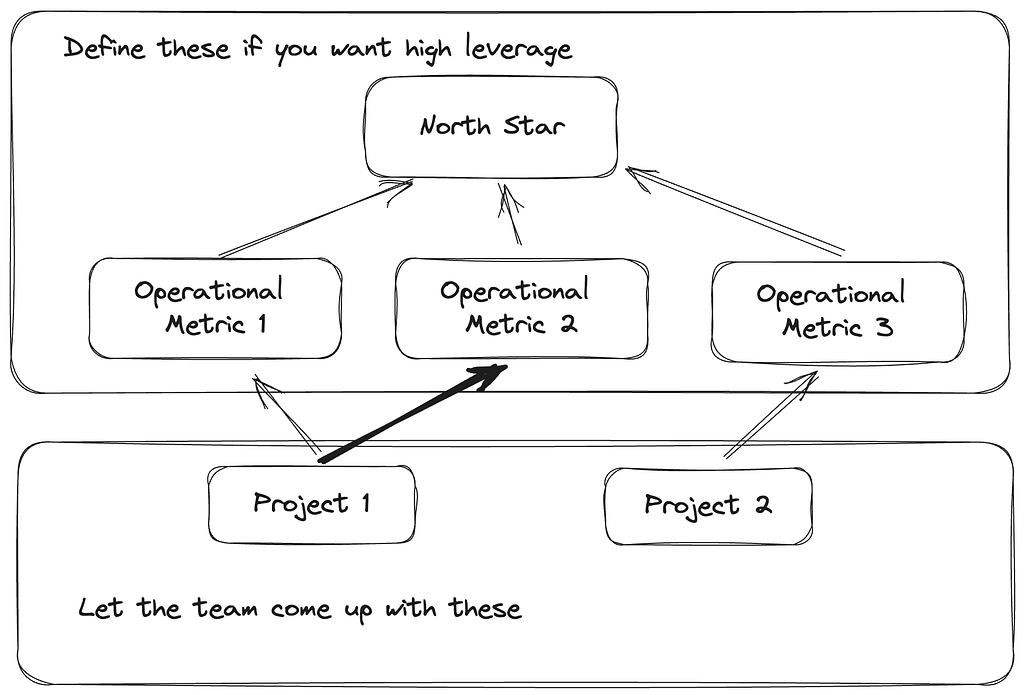
Every manager has the same number of hours in a day, yet some consistently achieve better results, foster innovation, and cultivate teams that are both happy and highly productive. What sets these managers apart? The secret often lies in their commitment to high-leverage activities.
As you navigate the labyrinth of management challenges, always remember that every individual you lead is an investment in the future. By focusing on high-leverage activities, you’re not just leading a team but building an enduring legacy of excellence, collaboration, and innovation. It’s crucial to remember that the true measure of success is not just in the achievements of the leader but in the collective triumphs and growth of their team.
Focus on top performers
Your life and career as a manager will be much more successful if you hire and retain great individuals on your team. It’s not uncommon to see managers with mediocre technical and strategic thinking succeed rapidly through their careers because they were able to hire, inspire, and also keep individuals that are simply amazing at execution. Top performers aren’t just assets; they are catalysts. They not only bring exceptional skills and passion but also elevate the entire team’s performance by setting high standards and mentoring others. Moreover, recognizing and appreciating their efforts is paramount. It not only fosters loyalty but also motivates them to push boundaries and innovate.
One common mistake I see is conflating dependency on an individual with top performance: “We need to keep Don because he is the only one who knows how this stuff works.” If you’re in this position, I’m sorry for you. I would encourage you to rapidly find a solution and to also design the right culture and processes in place that prevent you from being in a position of vulnerability. Focus on individuals that can drive impact while they also try to make themselves replaceable, not on those who keep you hostage.
Meetings
Paul Graham wrote insightfully about the aversion programmers have towards meetings. It’s often observed that meetings come at a higher cost for engineers, and the value they extract is often questionable. A root cause I’ve pinpointed is the inefficiency of how many meetings are conducted. Reflect on this: in a sizable number of meetings that bring together managers and individual contributors (ICs), the conversation is dominated by managers, often capturing more than 50%, and in some cases, even 80% of the total speaking time. This stark imbalance inadvertently muffles the voices of ICs, rendering their perspectives underrepresented or entirely unheard.
Now, if you’re a manager, let’s grapple with a thought-provoking question: “How can you truly understand the challenges your team faces or steer them towards a conclusive decision if you are perpetually in the spotlight, doing the bulk of the talking?”
This is why I think listening is a high-leverage activity and I encourage you to embrace active listening, set clear agendas, allocate time to speakers and encourage participation so that different perspectives are heard.
Align the team through metrics
I read an apocryphal story in Homo Deus about a group of Soviet economists visiting the UK, to exchange and compare economic theories. The hosts took the Soviets to a tour of a city, of the London Stock Exchange and the London School of Economics where they talked in length about economic policies. After a few hours, a Soviet expert burst out: “Wait a moment, please. Let’s table all the complicated economic theories. We’ve been through London back and forth for a full day and there is one thing I cannot understand. Back in Moscow, our finest minds are working on the bread supply system, and yet there are queues at every bakery. Here in London live millions of people yet I have not seen a single bread line. Please take me to the person in charge of supplying bread to London.”
There is obviously no central authority that decides how much bread should be produced in a given day and that it should be priced everywhere at £2/loaf. Instead, we rely on the “invisible hand” and economic incentives to drive and align millions of agents. In a similar vein, there is no single project or solution that will guarantee success in your company or career. Instead, you want to align people by pointing them to the north star and operational metrics and asking them to shape their own destiny. There are several second-order advantages to doing this:
- It helps you walk backward: Individuals and teams will have an easier time walking backward from the metric to the problem and then to the solution.
- Velocity: You’re more likely to encourage bottom-up thinking and ideation where team members can move much faster since they have a deeper understanding of the problem and what an optimal solution would look like.

As a final piece of advice on the north star: don’t pick something performative that only your team cares about (tickets closed, tables created, APIs developed, etc). Pick something real, something that can be measured in real economic impact, or something that everyone in the company cares about (e.g., headcount toil reduced, costs, revenue generated).
Hire for diversity
I believe many companies are giving up a large amount of value by being too standardized in how they hire engineering talent. If every team member is uniformly ‘good’ at everything but doesn’t excel in any particular area, the team might lack the diversity of thought and skill needed to innovate. On the other hand, a team composed of members each with their distinct strengths can be more dynamic, versatile, and creative.
Take, for example, a company that primarily hires based on Leetcode performance. Over time, it might find that its team increasingly consists of individuals who prioritize such skills. This can create a feedback loop where technical interviews revolve predominantly around Leetcode challenges. Similarly, if a data science team is predominantly filled with statisticians, it’s highly probable that subsequent hires will mirror this profile, offering little in terms of diversifying the team’s knowledge base.
Individuals with pronounced strengths in specific areas can often provide more value than those who are just ‘good’ across the board. For instance, if you’re hiring for an engineering position, a candidate who’s exceptionally skilled at API design but weaker in algorithms might drive significantly more impact, compensating for the minor shortfall in another area. The important trick though is that you need to hire for the strengths your team lacks, which does require more planning and effort in defining your hiring goals.
Think of it this way: rather than hiring the 50th engineer who knows how to Leetcode, why not hire an expert who knows databases really well and hyperfocus on assessing those skills? That way you can finally resolve some of your current database scaling problems that lead to innumerable P0s.
Have good onboarding and training
Andy Grove, the former CEO of Intel and author of “High Output Management” gave a very interesting mathematical justification for having good training and onboarding. As a manager, if you spend an extra hour on the job, you might get an extra hour of work done. However, if you spend that hour training someone else, that person might save an hour doing something more efficiently every day for months to come. If your training is done in a collective context where your advice and lessons can reach more people, you’re effectively getting very good leverage with hundreds of hours of productivity gained from less than a dozen hours of investment.
Unfortunately, most companies don’t do onboarding well. As a general rule, what I’ve seen is that folks put together an onboarding doc with general resources, and schedule a 1:1 once a week to answer questions between the manager (or onboarding buddy) and new hire. That’s a good start, but things could be improved. I found that the following onboarding tricks provide high leverage.
- Schedule daily 1:1 with the new hire to help them answer ANY questions they have. I usually keep the daily cadence for two weeks for senior people and up to one month for more junior folks. I can often tell if a candidate will become successful within two weeks not based on the questions they ask but on the quantity of questions. If they tell me on Day 5, “I don’t have any questions,” that often tells me that they are not learning enough, which is a very unusual thing to happen when you first join a company.
- Well-defined starter project: set them up with a starter project that is very well-defined in scope and complexity and that can be delivered within one month. This project should also give them the opportunity to spin up new initiatives or offshoots. It shouldn’t be a “fix a bug” project or a project that is effectively a dead-end once it is completed. It should be something meaningful, impactful, and doable.
- Trim down the noise: Organizations generally have too much documentation that is outdated or irrelevant. I would also be the filter that can immediately point them out to relevant and high-quality documentation or can connect them to other people in the org.
- Pair program: I would often pair program with them using live coding functionality. This allows me to guide them through the codebases in more detail, often with a debugger, and also gives them a glimpse into what my local setup looks like so that they can mirror it.
- Levels expectation: Lastly, I would literally open the levels expectation doc and walk them through it. It can be very discouraging if you join a company and nobody tells you how performance is measured or what good performance means. Being upfront about expectations is more likely to lead to alignment and “no surprises” during the review period.
Conclusion
The role of an engineering manager extends beyond just supervising tasks and processes. It’s a blend of strategic thinking, fostering inclusivity, recognizing potential, and constantly innovating on best practices. Effective engineering managers recognize that their impact is magnified by enabling their teams to thrive. Prioritizing high-leverage activities — from harnessing the power of top performers, streamlining meeting dynamics, using metrics as a compass, and championing diversity in hiring, to investing in robust onboarding and training — can make a significant difference.
Ultimately, the goal of every engineering manager should be to curate an environment where each team member feels acknowledged, understood, and empowered to take the reins of their own growth. By doing so, not only is there a surge in innovation and productivity, but it also fosters loyalty, talent retention, and consistent team performance. It’s crucial to remember that the true measure of success is not just in the achievements of the leader but in the collective triumphs and growth of their team.
High-leverage Activities for Engineering Managers was originally published in Better Programming on Medium, where people are continuing the conversation by highlighting and responding to this story.